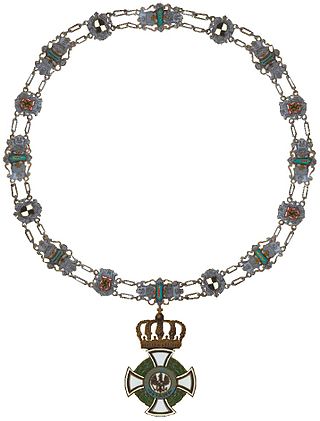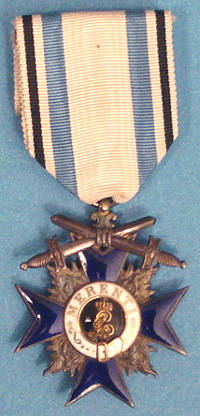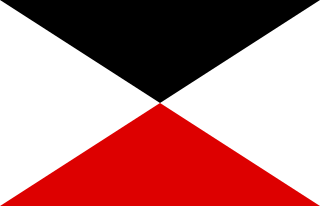
Fritz Theodor Carl von Below was a Prussian general in the German Army during the First World War. He commanded troops during the Battle of the Somme, the Second Battle of the Aisne, and the German spring offensive in 1918.

A Generaloberst was the second-highest general officer rank in the German Reichswehr and Wehrmacht, the Austro-Hungarian Common Army, the East German National People's Army and in their respective police services. The rank was equal to a four-star full general but below a general field marshal. The rank was equivalent to a Generaladmiral in the Kriegsmarine until 1945 or to a Flottenadmiral in the Volksmarine until 1990. It was the highest ordinary military rank and the highest military rank awarded in peacetime; the higher rank of general field marshal was awarded only in wartime by the head of state. In general, a Generaloberst had the same privileges as a general field marshal.

The House Order of Hohenzollern was a dynastic order of knighthood of the House of Hohenzollern awarded to military commissioned officers and civilians of comparable status. Associated with the various versions of the order were crosses and medals which could be awarded to lower-ranking soldiers and civilians.

The Bavarian Military Merit Order was established on 19 July 1866 by King Ludwig II of Bavaria. It was the kingdom's main decoration for bravery and military merit for officers and higher-ranking officials. Civilians acting in support of the army were also made eligible for the decoration. The Military Merit Order ranked below the Military Order of Max Joseph (Militär-Max-Joseph-Orden), which was Bavaria's highest military honor for officers.
The 28th Division was a unit of the Prussian and German Army, almost entirely made up of troops from the Grand Duchy of Baden. It was formed in Karlsruhe on 1 July 1871. The division was subordinated in peacetime to the XIV Army Corps. The 28th Division was disbanded in 1919 during the demobilization of the German Army after World War I.

The Military Order of St. Henry was a military order of the Kingdom of Saxony, a member state of the German Empire. The order was the oldest military order of the states of the German Empire. It was founded on October 7, 1736 by Augustus III, King of Poland and Elector of Saxony. The order underwent several more revisions over the course of the 19th and early 20th centuries. It became obsolete with the fall of the Saxon monarchy in the wake of Germany's defeat in World War I.
This is the German Army order of battle on the outbreak of World War I in August 1914.

The 1st Army was an army level command of the German Army in World War I. It was formed on mobilization in August 1914 from the VIII Army Inspectorate. The army was dissolved on 17 September 1915, but reformed on 19 July 1916 during the Battle of the Somme. It was finally disbanded in 1919 during demobilization after the war.

The 2nd Army was an army level command of the German Army in World War I. It was formed on mobilization in August 1914 from the III Army Inspection. The army was disbanded in 1919 during demobilization after the war.

The 5th Army was an army level command of the German Army in World War I. It was formed on mobilization in August 1914 seemingly from the VII Army Inspection. The army was disbanded in 1919 during demobilization after the war.

The Guards Reserve Corps was a corps level command of the German Army in World War I.

The XV Royal Bavarian Reserve Corps / XV Bavarian RK was a corps level command of the Royal Bavarian Army, part of the German Army, in World War I.

This is the order of battle for Operation Michael, part of the German Spring Offensive fought from 21 March to 5 April 1918 as one of the main engagements of the First World War. It was fought between mixed French, British and Dominion forces and the German Empire in the Somme region in northern France.

The leaders of the Central Powers of World War I were the political or military figures who commanded or supported the Central Powers.

Max Ferdinand Karl von Boehn was a Prussian and German officer who served in the Franco-Prussian War and World War I. He reached the rank of Generaloberst and held several high commands in World War I. He was decorated with the Pour le Mérite with Oakleaves, Prussia's highest award for military valor.
The Army Group Boehn was an Army Group of the German Army, which operated on the Western Front under command of Max von Boehn, between 12 August 1918 and 8 October 1918 during World War I.
Army Group Gallwitz, or Army Group C, was an Army Group of the Imperial German Army during World War I. Commanded by Max von Gallwitz, it operated on the Western Front between 1 February and 11 November 1918.

The Army Group Rupprecht of Bavaria or Army Group A was an Army Group of the German Army, which operated on the Western Front under command of Rupprecht, Crown Prince of Bavaria, between 28 August 1916 and 11 November 1918 during World War I. It was formed from the short-lived Army Group Gallwitz under Max von Gallwitz.

The Army Group Duke Albrecht or Army Group D was an Army Group of the German Army, which operated on the Western Front under command of Albrecht, Duke of Württemberg, between 7 March 1917 and 11 November 1918 during World War I.
The Army Group Hindenburg was an Army Group of the German Army, which operated in the Baltics against Russia between 5 August 1915 and 30 July 1916 during World War I, under command of Ober Ost Paul von Hindenburg.
This page is based on this
Wikipedia article Text is available under the
CC BY-SA 4.0 license; additional terms may apply.
Images, videos and audio are available under their respective licenses.












